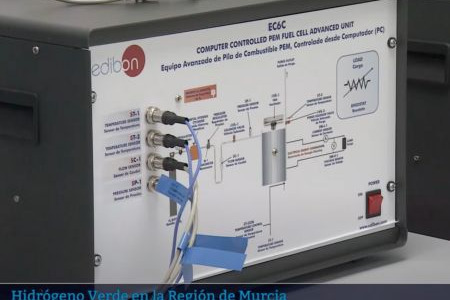The Photovoltaic Power Plants Application, with SCADA, ''AEL-PHVGC'', has been designed to study the operations carried out in photovoltaic power systems connected to the energy national grid. This application allows to study the procedure of dynamic control of active power injected in the electrical network through the smart inverter. In addition, this application allows the local control of the voltage in nodes of the network, as well as the study of energy storage in batteries by means of hybrid inverters.
In addition this application allows the analysis of the characteristic curves of the photovoltaic panel. For that end, the ''AEL-PHVGC'' application consists of different kits that allow studying the different aspects of photovoltaic power plants:
- PHVGC-K1. Photovoltaic Modules Analysis Kit:
This kit consists of a photovoltaic module assembled on a wheeled frame that allows varying the solar module tilt angle. Thus, different roof tilts or typical frame can be simulated, above which these photovoltaic modules are installed. An halogen lamp assembled in an articulated arm is coupled to the mentioned frame for the sun's path simulation. The lamp has a current regulator which allows controlling the incident irradiance on the photovoltaic panel. In order to simulate the solar panel load, the kit includes a variable resistive load.
With this kit, the user will be able to acquire the following learning: visualisation of daily and annual curves, calculation of the optimal orientation of photovoltaic modules and visualisation of characteristic curves of photovoltaic modules.
- PHVGC-K2. Three-Phase Photovoltaic Power Plants Kit in Parallel with the Grid:
This kit is composed of all the industrial elements necessary to study a real photovoltaic power plant. Firstly, it has a three-phase grid inverter powered by a photovoltaic panel array simulator. A network analyser is connected to the inverter output, which will show the user all the electrical parameters generated by the inverter. In addition, a three-phase resistive load is also included to simulate different consumption conditions. Finally, the three-phase power supply allows the user to simulate the conditions of the electrical grid and the connection of the inverter to it.
With this kit, the user can acquire the following training: installation of photovoltaic plants, grid connection of photovoltaic plants, measurement of the electrical parameters coming from the photovoltaic plant, monitoring of the maximum power point, programming of the inverter power limitation "derating", generation of reactive energy, determination of the inverter yield, recording of yield data by means of a solar path simulator, analysis of the behaviour of the photovoltaic plant in the event of a "black-out", protection of photovoltaic plants against lightning strikes, etc.
- PHVGC-K3. Voltage Regulation in Local Power Grids Kit:
This kit is a complement to the PHVGC-K2. It consists of a set of power elements for the simulation of voltage-regulated photovoltaic power plants at a specific point in the grid. The three-phase grid inverter feeds power into the national grid by means of a galvanic isolation transformer and a motorised voltage regulating transformer included in this kit. Due to changes in power demand caused by the variable three-phase load, voltage variations will occur which will have to be compensated by means of the motorised transformer (included). This compensation/regulation can be done either manually or automatically by means of a network analyser programmed to detect over/under voltage thresholds (included) and thus control the motorisation of the transformer.With this kit, the user will be able to acquire the following training: study of the local grid transformer, programming of the power limitation of the inverter of the photovoltaic plant "derating", manual and automatic regulation of the local grid voltage and visualisation of the parameters from the SCADA software.
- PHVGC-K4. Energy Storage Analysis Kit with Batteries:
This kit is a complement to the PHVGC-K2. It consists of an energy storage system using a three-phase hybrid inverter-charger (included) and a high-capacity battery (included). Ideally, this kit should be combined with the PHVG-K2 to study the optimal complement between the use of electrical energy from the grid and electrical energy from the battery. It is the perfect complement to any electrical installation of the future, given the energy and economic savings that can be achieved by combining this technology.
With this kit, the user will be able to acquire the following knowledge: installation process of energy accumulation systems in batteries in combination with the inverter charger, system start-up, interaction between the photovoltaic system and the battery, increase in efficiency through self-consumption.
This Computer Controlled Unit is supplied with the EDIBON Computer Control System (SCADA), and includes: The unit itself + Computer Control, Data Acquisition and Data Management Software Packages, for controlling the process and all parameters involved in the process.
 Cookies首选项
Cookies首选项




























